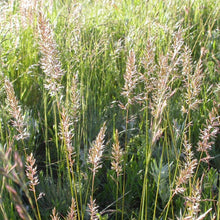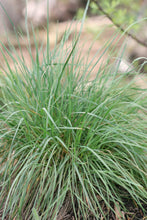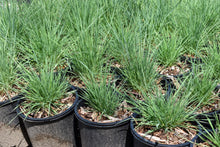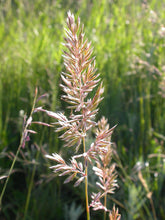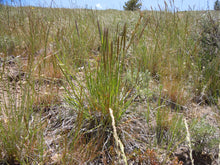
Koeleria macrantha
Prairie junegrass is a cool-season perennial grass that forms light green tufts around two feet tall. Flowers appear in late spring to early summer as silvery, light green plumes dancing on tall stalks, above the dense, bunching vegetation below. By mid-summer the plumes turn tan and some or all of the plant may go dormant until fall. It is an ideal replacement for ornamental bunch grasses.
- Plant type/canopy layer: deciduous, perennial, grass
- Size at maturity: 0-36" tall, 0-24" wide
- Light requirements: full sun
- Moisture requirements: dry to moist soil, prefers well-drained
- Bloom time: May - June
- Growth rate/ease: medium growth rate, easy to grow
- Wildlife support: flowers attract and support bees and other insect pollinators; mid-summer dormant form is excellent habitat for invertebrates; overall plant is a caterpillar host and larval food source for native butterflies and moths, including the Nevada Skipper (Hesperia nevada)
- Native habitat/range: typically found in specific habitat types such as grasslands, meadows, upland prairies, forest openings, savannas from sea level to 2900m throughout much of North America, except the Atlantic coast. Portland Plant List - yes.
- Special features & uses: drought-tolerant; deer resistant; landscape uses include rangeland revegetation, grazing, meadowscapes, pollinator gardens and rock gardens; grows well under Black Walnut trees; tolerates air pollution making it a good fit for the urban environment and green roofs
Gardening with Prairie Junegrass: This is a super-easy plant to grow. Simply give it a sunny location with well-drained rocky or sandy soil. Avoid wet and/or heavy soils or shade. It’s extraordinarily drought-tolerant and generally a great fit for harsher urban environments like parking strips and green roofs, provided the drainage is good. After flowering, it will likely go dormant in the peak of the summer, and return to its more attractive state in fall. However, mid-summer dormancy should not be considered unsightly as it provides excellent invertebrate habitat; habitat = beauty! This species works well mixed into meadowscapes and rock gardens with other upland grasses and wildflowers, rather than as the centerpiece or part of a conspicuous border. Will self-seed in optimum growing conditions.
Photo Credits 1, 4 - 6: "Koeleria macrantha" by Matt Lavin is licensed under CC BY-SA 2.0.
Photo Credit 2: Karli Del Biondo, Beetles and Bees
Photo Credit 3: Nikkie West, Sparrowhawk Native Plants






